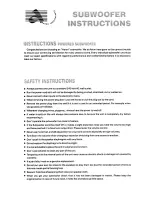
中文
EN
D
APPLICA
TIONS
35
34
SUBWOOFER ARRAYS
The wavelength of the frequencies reproduced by any subwoofer, are usually much larger than its physical
dimensions. Due to this, most of them have no control over directivity, and their radiation pattern in the
pass-band is omnidirectional. In order to improve this behaviour and to introduce some directivity in the
intended direction, gradient subwoofer setups are used. In addition, some of their main benefits are:
1. Reduced low frequency SPL behind the subwoofers and thus, reduced overall SPL on the stage. This
helps to reduce low frequency bleed in the microphones and may improve the comfort, monitoring
and performing for the musicians.
2. Reduced reflections indoors for a more homogeneous sound field, as sound is more directed towards
the audience.
3. Reduced energy spill outside of the venue area, reducing noise towards the households and living
areas around.
From their design, the B-Line subwoofers include different features to optimise this phenomenon, getting
the best possible performance out of it. This is also reflected in the physical deployment of the setups,
reducing time and resources during their placement and wiring.
Two of the main types of gradient subwoofer setups are the "Cardioid" and the "End-Fire", detailed below.
END-FIRE SETUP
In end-fire setups, two or more subwoofers are placed behind each other to introduce between them a
delay, which changes the interaction of the sound in the front and the rear sides, and reduces the level
in the desired direction. The cancellation of the rear sound occurs mainly around the centre or "tuning"
frequency of the setup.
Usually, end-fire setups provide around 15 dB to 25 dB level reduction in the rear and are easy to set up.
Their main drawback however is the space requirement, which may be a problem in some applications.
That is why in most of the cases, the subwoofers are placed ¼ wavelength apart and the additional delay
of ¼ wavelength is introduced electronically.
Figure 35 illustrates an end-fire setup with
B 15
or
B 15A
subwoofers 1.25 m distant. For this distance, an
additional delay of approximately 3.64 ms should be added to the front subwoofer to create the highest
reduction in the rear around 69 Hz, over their main operating band.
In
B 15A
self-powered subwoofers, the Directivity function of the DSP allows to configure this setup easily:
1. For the subwoofer placed in front of the line, enable "
End-Fire
" mode in the Directivity menu by
selecting the desired centre frequency of attenuation. Below in the screen, observe the distance
calculated for that frequency. This distance must match the real separation of the subwoofers from
grille to grille.
2. For the subwoofer placed rear, select the "
Normal
" preset in the Directivity menu.
The distance between subwoofers is calculated at reference room temperature 20 °C,
and taking the speed of sound
c
= 343 m/s.
All the additional processing like level, polarity, delay and EQ, should be done identically to
all subwoofers within the end-fire setup, in order to maintain proper phase relations for
directivity control.
FRONT
(Audience)
1.25 m
REAR
(stage)
Figure 35.
End-fire setup with two
B 15A
subwoofers centred at 69 Hz.









































